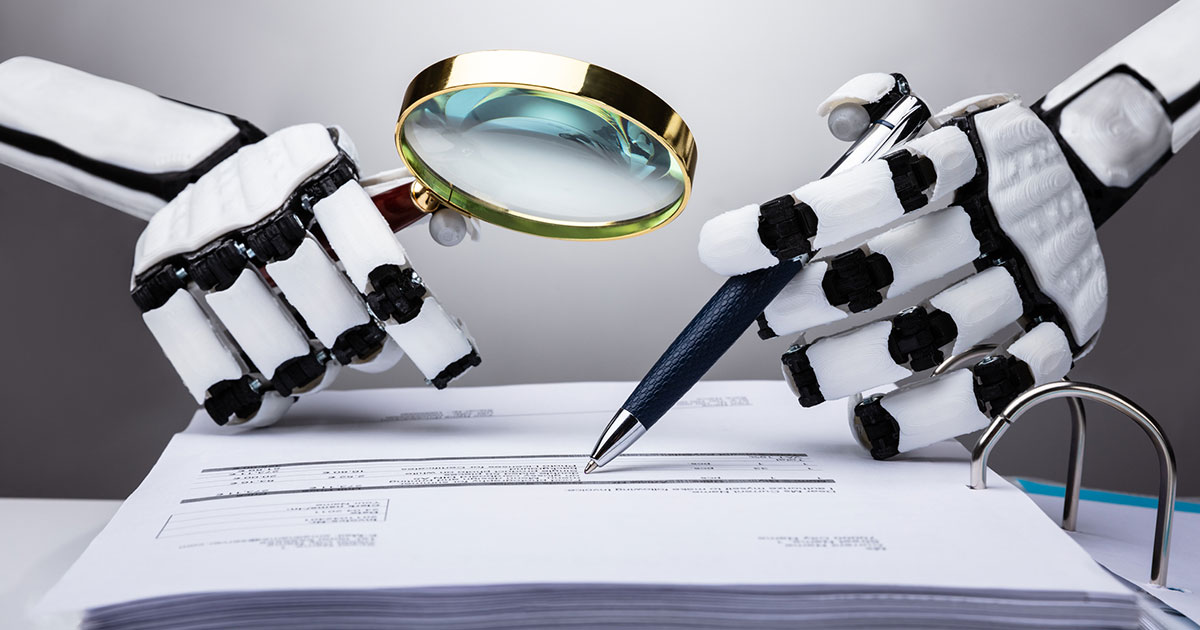
Feb. 7, 2024 – Proponents of artificial intelligence (AI) claim the new technology will transform the practice of law.
Generative AI scrapes data from across the internet, then puts the data through large language models (LLM) to learn how to predict word order, so that it can respond to user prompts – for instance, “Write a haiku about a cat.”
In the 15 months since ChatGPT hit the market, time-starved attorneys have learned to use AI to generate first drafts of blog posts and do legal research. They’ve also used AI to handle the drudgery of document review.
Drafting transactional documents is a natural next frontier for AI. But before attorneys fire up ChatGPT to bang out a simple will or service contract, they should consider practical and ethical issues.
Useful in Getting Started

Brent Hoeft, practice management advisor for the State Bar of Wisconsin’s Law Practice Management Assistance Program (Practice 411®), said AI is well-suited to help lawyers get started on transactional documents, as long as you tailor your prompts.
“If you put bad instructions out there, you’re not likely to get the results that you’re looking for,” Hoeft said.
For instance, Hoeft said, if you ask AI to “Write an employment contract,” without specifying the industry, job title, or essential issues, the agreement AI creates won’t likely be what you need.
Hoeft said you shouldn’t plan on using that agreement without heavy editing any more than you would cut and paste wholesale the first document that came up when you googled “employment contract.”
“You’re going to get a whole bunch of different forms of varying usefulness and quality,” Hoeft said of the hypothetical Google search. “You shouldn’t just paste that and say, ‘I’m good to go.’”
Rather, Hoeft advised that attorneys regard an agreement created by AI as a skeleton to which the attorney will need to add flesh and sinew to in the form of additional provisions – for instance, an appropriate choice-of-law provision or indemnification and liquidated-damages clauses congruent with the law of the governing jurisdiction.
“It can be useful in getting you started,” Hoeft said.
AI for Comparison, Analysis
According to Hoeft, AI is better suited to analyzing existing documents and comparing them to a draft document.
“Let’s say you’re in a larger firm with a library of documents,” Hoeft said. “AI can go out there and find similar types of documents and ask, ‘Would you like to include this type of provision, because your document is missing that provision.’”
“Maybe you’ve drafted a provision that includes a term that’s not defined,” Hoeft said. “AI can say, ‘This appears to be something that should be a defined term – would you like to define this term?’ It can really be helpful in making your document stronger.”
Craft Verses Convenience

For Professor Andrew Turner, contract drafting is an art not easily outsourced to AI.
Turner, who teaches contract drafting at the U.W. Law School, said the mark of a well-drafted contract is conscious word choice informed by the goals of the client and intent of the parties.
A prime example, Turner said, is knowing when to use “shall” instead of “will,” and knowing why to use “shall” instead of “will.”
AI can’t make conscious word choices, Turner said, because its intelligence is only predictive.
“AI isn’t making that type of informed choice,” Turner said. “It’s just saying, ‘This is what I tend to see.’”
Bad Diet
According to Turner, another problem with using AI to draft contracts is the data fed into the LLM used by the AI.
“There’s a lot of subpar contracts that are floating around in the world, and that’s what it’s learning on,” Turner said. “It’s not necessarily going to give you back quality work; it’s going to give you back, at best, the average of what it sees out in the world.”
To drive his point home, Turner compared contract provisions – which aren’t truly tested until they become the subject of litigation – to the oxygen masks above airline seats.
“Ninety-nine times out of a hundred, it doesn’t deploy – you just assume it works,” Turner said. “That one time it does deploy, you have to be able to count on it. The problem with a lot of contract wording is that people keep using a lot of bad wording and the provision never ‘deploys’ so they don’t know if it works or not.”
‘Minefields’
Turner has his students stress-test proposed contract wording – asking how the wording might be interpreted (or misinterpreted) by a court. There’s no guarantee AI does the same thing when drafting a contract, Turner said.
“It spits out stuff that looks fine, but if you don’t have that understanding of where the minefields are, you’re just not going to see it,” Turner said.
“The whole point of contract drafting is to have a robust understanding of the parties and what they’re trying to accomplish and what their risk tolerance is,” Turner said. “For instance, ‘How might I tweak this standard term to achieve a certain result?’”
“If AI is spitting out a ‘perfect draft’ that works and I don’t understand why it works, then there are no real client services that I can provide.”
Turner thinks attorneys should be as wary of using AI to draft a contract as they would be copying a sample contract out of a practice manual. It’s a stance informed by his experience as a young attorney, when a mentor forced him to begin each contract with a blank sheet of paper.
“The reason was, as soon as you see a template, it structures your thinking,” Turner said. “I want you to write it from your own brain, from what you think. Then, when you’re done, look at the template and find what you didn’t think of, and what you missed. You check the creativity of your own thinking against the template.”
‘Finding a Balance’
Turner admits that AI is well-suited to comparing existing contracts, and, for example, searching a single contract to ensure that the drafter has used the word “shall” consistently – as long as the attorney has a deep familiarity with the contract.
“There’s a danger of over-reliance, especially if you don’t really know the nuts and bolts,” Turner said.
Turner said he likes to think of AI as a calculator: something to be used for rote and uncreative tasks, the way we use calculators for long division.
“AI is the type of thing which, if used correctly, I expect will become very useful to attorneys,” Turner said. “It’s about finding a balance.”
‘It Makes Things Up’

Tim Pierce, ethics counsel for the State Bar, said that attorneys have an obligation to be aware of the limits of AI before using it in their practices.
He cited several recent examples when litigation documents created with the help of AI were larded with wholly fictitious case citations.
“If you use this technology in your practice, you have to understand that it’s not reliable,” Pierce said. “It hallucinates, it makes things up.”
Those examples, Pierce said, serve as a reminder that an attorney is responsible for his or her assertions to a tribunal.
The Perils of Prompts
Another issue raised by using AI to create legal documents, Pierce said, is including client information in prompts.
“If I’m saying, ‘Draft something about Client X arguing for proposition Y,’ that’s protected information,” Pierce said. “The lawyer is obligated to protect, not only information that directly relates to the representation, but that is reasonably likely to lead to disclosure of such information.”
“The lawyer needs to understand what’s going on with the terms of service and the way the AI tool that they’re using does with the information they’re putting into it,” Pierce said.
“It would be a violation of Rule 1.6 to hurl a bunch of client information into an algorithm honed by a commercial provider who is going to use that information to respond to prompts from other users.”
Rule 1.6 would allow an attorney to include in a prompt client information that’s been anonymized so the client cannot be identified from the information. But that can be hard to do, Pierce said.
For instance, including the address of a house, the make and model of a vehicle, and the make and color of a vintage guitar in a user prompt designed to allow AI to write the first draft of a will would likely violate the rule, Pierce said.
Beware Billing Practices
Pierce said attorneys also need to be careful how they bill their time when using AI.
The rules prohibit an attorney billing for time that he or she doesn’t expend, Pierce said.
“Law firms should be mindful that they don’t pad their time, and say, ‘We used to bill a client five hours for a contract like this, but now we can get it done in one with AI,” Piece. “Well, then you can’t bill the client five hours for that contract.”
In other words, attorneys can’t bank the productivity increases enabled by AI.
The added value from using AI, Pierce said, must come instead from attorneys using their freed-up time for marketing, or from raising their hourly rates because they’re now more productive because of AI.
Leveling the Playing Field?
AI can be a game-changer for solo and small-firm attorneys who find a way to ethically incorporate it into their practices, said Hoeft.
Big firms have always had the resources to throw squads of lawyers at a daunting task, like document review or drafting a big contact on short notice. Now, said Hoeft, solos and small firms can use AI to do the same thing.
“It has great potential to be a leveler, because now solo practitioners and small firms can go and do, for example, huge amounts of discovery that without AI would be too expensive to do.”
